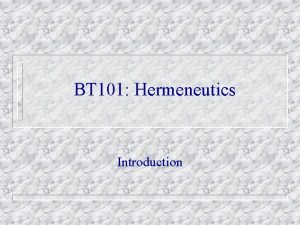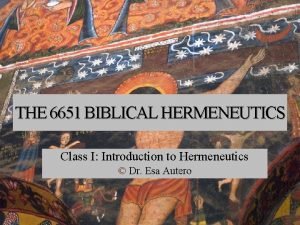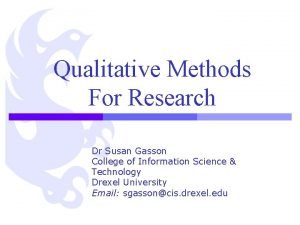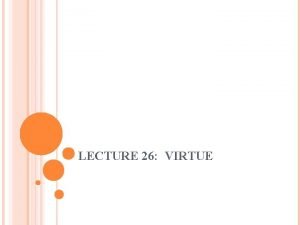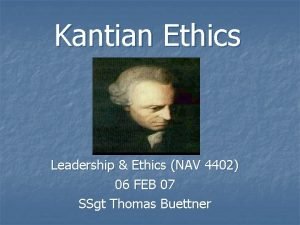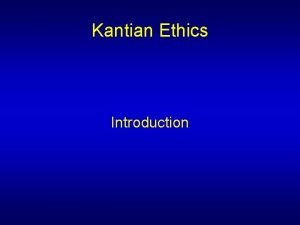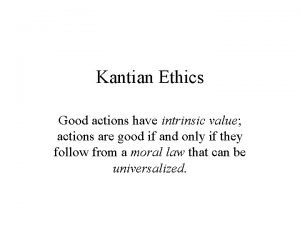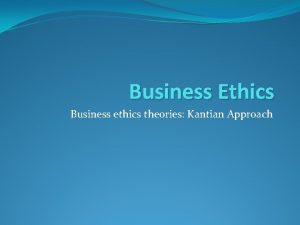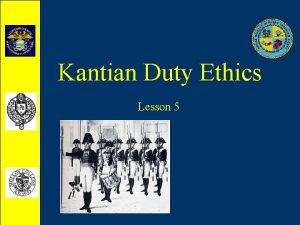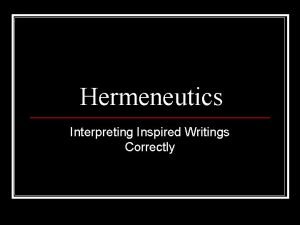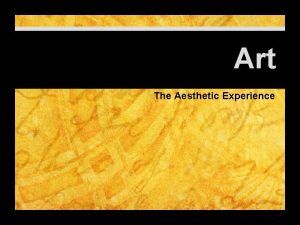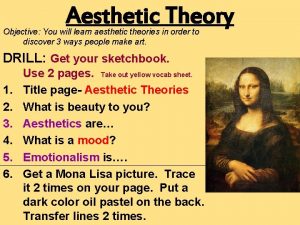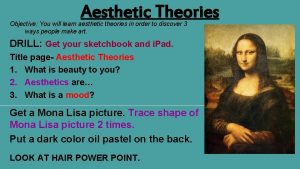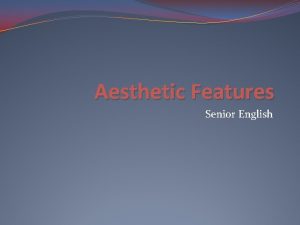Transforming Kantian Aesthetic Principles into Qualitative Hermeneutics for













- Slides: 13

Transforming Kantian Aesthetic Principles into Qualitative Hermeneutics for Contemplative AGI Agents Jeremy O. Turner & Steve Di. Paola Simon Fraser University Cognitive Science School of Interactive Arts and Technology (SIAT) Vancouver, B. C. , Canada Jeremy – jot@sfu. ca Steve – sdipaola@sfu. ca

INTERDISCIPLINARY APPROACH: Technological (AI/AGI), Philosophical (Aesthetic), Social Sciences (Cognitive Science)… This research used an exclusively qualitative methodology to assess the cognitive capabilities of artificially intelligent-agent minds. This research is based on parts of a committee-approved dissertation (ready for external review)…

Philosophical Research Question To what degree can Kant’s Aesthetic (cognitive) intensity levels* semantically correspond with the contemplative capabilities underlying Russell & Norvig’s intelligent-agent categories? ** * Critique of Judgment, 1790 **(1994 -Present)

1. Goals To map 4 Kantian aesthetic intensities (mundane, agreeable, beautiful, transcendent sublime) to Russell & Norvig’s 5 intelligent-agent categories (simple-reflex, model-based reflex, goal-based, utility-based, learning) [+ higher categories such as the universal knowledge-seeking agent – Orseau and Ring, 2011; Orseau et al. , 2013] 2. 3. To endorse aesthetic engineering principles for AGI-agent cognitive design… To qualitatively assess the mechanistic thresholds for “reason” and “imagination” in an AGI-agent’s mind…

Hermeneutic Considerations The Kantian aesthetic intensity levels can be partially mapped to Russell and Norvig’s Intelligent Agent categories as cognitive (contemplative) intensities. However, this mapping is not straightforward… Each Kantian category cannot be applied neatly to each intelligentagent category… However, Kant’s cognitive interplay(s) between reason and imagination can be discussed in terms of each intelligent agent-level’s increasingly deliberative capabilities. Kantian cognitive capabilities can also be viewed in terms of relative self-interest vs. disinterest

Kantian Aesthetic Intensities and Russell/Norvig’s Intelligent-Agent Categories

Kantian Aesthetic Intensities Mundane (lowest) Hardly any cognition involved… Intensity for “mindless” tasks (incl. domestic tasks and superficial chat-bot interaction). Reason is automatic (maybe autonomic)… No imagination/simulation/planning involved. A simple-reflex (i. e. subsumption level) agent comes to mind (see Brooks, 1991).

Kantian Aesthetic Intensities Agreeable/Disagreeable (moderate) Thinking according to fulfilling its own goals, desires (drives), and motivations (self-interest). Reason and predictability is preferred over imagination and unpredictability (unless the thrill of novelty is involved). Agents maximize reasonable estimation to comfort the imagination. A comfortable balance between reason and imagination ideally puts an agent in an agreeable cognitive state. Goal-based agents are most ideally suited towards (strictly) explicit agreeable contemplation… It is plausible that a model-based reflex agent might implicitly (and/or tacitly) address agreeable contemplation…

Kantian Aesthetic Intensities Beautiful/Ugly (high) Disinterestesness: Agents contemplate phenomena for their own sake (regardless of fulfilling goals, motivations, aspirations etc. ). The imagination is allowed to wander as long as the agent can still reasonably estimate what is being contemplated… Imagination and reason can temporarily go out of balance… ***An intelligent-agent would likely require an understanding of utility in order to determine whether to contemplate in a self-interested or disinterested manner…

Kantian Aesthetic Intensities Transcendent Sublime The cognitive threshold where the imagination outpaces reasonable estimation… Sanity is only attained if some reasonable estimation is imaginable…Otherwise, the agent cannot properly perceive (and make sense of) what is being imagined/experienced… An agent that is capable of intensifying imagined states without being reasonably overloaded would most likely correspond to learning categories or higher (e. g. knowledge-seeking).

Research Value (AGI community) -Encourages inter-disciplinary analogies and understanding(s)… -Raises the question(s) of whether teleological cognitive representations could/should be designed for a contemplative AGI agent. -Reminds the community that there are different modalities of contemplation (i. e. possibly higher-level deliberation, self-awareness, self-reflection etc. ) that could possibly be engineered (e. g. architecturally) by the AGI mind-designer. -Questions whether the artificial categorization of intelligence should only measure “[…] an agent’s ability to achieve goals in a wide range of environments” (Legg and Hutter, 2007 p. 8). Are truly intelligent-agents only those that achieve their self-interested goals and utilities (and nothing else) or are there also deeper qualitative aspects of intelligence (i. e. “deep-thinking”) that an AGI-agent should possess? FUTURE WORK FOR SOMEONE ELSE: Representing the transcendent sublime (the cognitive threshold) in terms of Algorithmic Information Theory (AIT) and computability limits.

END OF PRESENTATION

Chapter References • • • • • Barbosa Fernandes, P. C. , Guizzardi, R. S. S. , Guizzardi, G. Using Goal Modeling to Capture Competency Questions in Ontology-based Systems. Journal of Information and Data Management, 2(3), 527 -540 (2011). Brooks, R. A. (1991). Intelligence without representation. Artificial intelligence, 47(1 -3), 139 -159. Burke, E. [1756]. A Philosophical Enquiry into the Origin of our Ideas of the Sublime and Beautiful. South Bend, University of Notre Dame Press (1968). De Blanc, P. Ontological Crises in Artificial Agents' Value Systems. In: The Singularity Institute [The Machine Intelligence Research Institute], pp. 1 -7. San Francisco, CA (2011). Dewey, D. (2011). Learning what to value. In: Artificial General Intelligence (pp. 309 -314). Springer, Berlin (2011). Gennari, J. H. , Musen, M. A. , Fergusen, R. W. , Grosso, W. E. , Crubézy, M. , Eriksson, H. , . . . & Tu, S. W. (2003). The evolution of Protégé: an environment for knowledge-based systems development. International Journal of Human-computer studies, 58(1), 89 -123. Goertzel, B. Pennachin, C. Artificial General Intelligence. Springer, New York, NY. (2007). Kant, I. [1790]. Critique of Judgment. Werner S. Pluhar [Trans. ]. Hackett, Indianapolis (1987). Kant, I. [1781]. Critique of Pure Reason. J. M. D. Meiklejohn [Trans. ]. Courier Corporation, North Chelmsford (2003). Legg, S. , & Hutter, M. (2007). A collection of definitions of intelligence. Frontiers in Artificial Intelligence and applications, 157, 17. Li, J. , Laird, J. E. The Computational Problem of Prospective Memory Retrieval. In: Proceedings of the 17 th International Conference on Cognitive Modeling, pp. 1 -6. Ottawa, Canada (2013). Marques, H. G. , Holland, O. Architectures for Functional Imagination. In: Neurocomputing 72(4 -6), 743 -759 (2009). . Nivel, E. , Thórisson, K. R. , Steunebrink, B. R. , Dindo, H. , Pezzulo, G. , Rodriguez, M. , Hernandez, C. , Ognibene, D. , Schmidhuber, J. , Sanz, R, Helgason H. G. , Chella, A. , Jonsson, G. K. Bounded Recursive Self-Improvement. ar. Xiv preprint ar. Xiv: 1312. 6764. Orseau, L. , Lattimore, T. , & Hutter, M. (2013). Universal knowledge-seeking agents for stochastic environments. In International Conference on Algorithmic Learning Theory (pp. 158 -172). Springer, Berlin, Heidelberg. Orseau, L. , & Ring, M. (2011). Self-modification and mortality in artificial agents. In Artificial General Intelligence (pp. 1 -10). [J. Schmidhuber, K. R. Thorisson, and M. Looks, Eds. ]. Springer Berlin Heidelberg. Russell, S. Norvig, P. Artificial Intelligence: A Modern Approach. 3 rd edn. Prentice Hall, Englewood Cliffs (2010). ; Russell, S. Learning agents for uncertain environments. In: Proceedings of the eleventh annual conference on Computational learning theory, pp. 101 -103. ACM, Madison, WI. (1998). Uttal, W. R. The war between mentalism and behaviorism: On the accessibility of mental processes. Psychology Press, Philadelphia, PA (1999). Veale, T. , & Li, G. Creative Introspection and Knowledge Acquisition: Learning about the world thru introspective questions and exploratory metaphors. In: Proceedings of the AAAI, pp. 1 -7. San Francisco, CA (2011). Zilberstein, S. Metareasoning and Bounded Rationality. In Metareasoning: Thinking About Thinking. Cox. , M. T. , Raja, A. 2011 [Eds. ]. Pp. 27 -40. Cambridge, MIT Press: Cambridge (2011).



